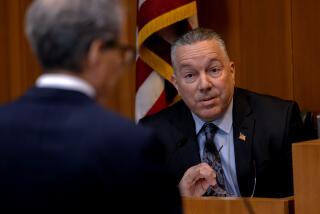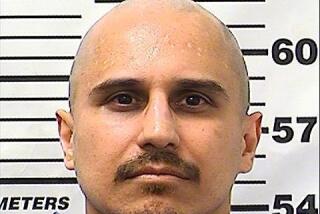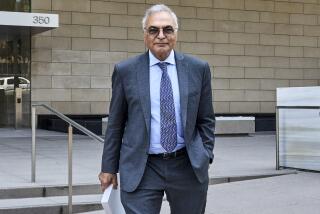Squaring Off Over Nominee
TUCSON â When Health and Human Services Secretary Tommy G. Thompson first sat down to talk with Richard Carmona about becoming surgeon general, the candidate seemed almost too good to be true.
An up-from-nothing New York City street kid from Harlem. A high school dropout turned decorated Vietnam War veteran turned trauma surgeon. A moonlighting SWAT team member who shot a suspect dead to protect others and dangled from a helicopter in a daring mountain-side rescue.
White House aides touted the father of four, married to his high school sweetheart, as a real-life Indiana Jones.
âYou interview this guy, and itâs like reading a novel,â Thompson told reporters gathered for the White House announcement of Carmonaâs nomination in March. âI said, âAre you really real?â And he said, âAbsolutely.â â
But a close look at Carmonaâs extraordinary career, based on dozens of interviews and hundreds of documents, reveals a more complex answer to that question. With his Senate confirmation hearings set to begin Tuesday, many who know him well, here in his adopted hometown, say they know another side of the man:
An administrator who was forced out of two top management jobs. A boss who had an uncommon rapport with patients but infuriated colleagues. A surgeon who took years to earn board certification. A combination doctor and sheriffâs deputy whose exploits were not quite as sensational as the newspaper accounts.
A larger-than-life personality, he has left in his wake many bruised egos and hard feelings. His critics point out that he has benefited at many turns in his life from rules being bent in his favor. He got into medical school without a college degree. He became a sheriffâs deputy without taking the examination. He ran a trauma unit for eight years even though he hadnât passed board exams.
But he also made staunch allies. When his job was eliminated as head of Tucson Medical Centerâs trauma unit in 1993, he sued for breach of contract, eventually winning a multimillion-dollar settlement and a full-page apology in a local newspaper from hospital officials. The judge who mediated the settlement, Larry Fleischman, ended up a good friend. He dismissed controversies that have followed Carmona throughout his two decades here as rooted in envy and jealousy.
âSometimes the story is that there is no story,â said Fleischman, now a lawyer in private practice. âHe is the real deal.â
A number of Carmonaâs former co-workers and employees, however, describe a man whose instinct is to escalate hostilities rather than resolve them. When President Bush said at the White House nomination ceremony that Carmona would bring âa strong management backgroundâ as head of the 5,600-member corps of public health officers, former colleagues interviewed here say they were stunned.
Concerns about Carmonaâs professional record led one Tucson doctor to write to Sen. Edward M. Kennedy (D-Mass.), the chairman of the committee reviewing Carmonaâs nomination.
Charles W. Putnam, a University of Arizona surgery professor who has worked with Carmona, told Kennedy in the letter that he did not want as his surgeon general someone âwho was removed from his two previous administrative appointments ... because he could not work in an effective or even a civil manner with health professionals and other constituencies of those positions.â
Carmona, on standard White House orders to nominees, has declined interviews before his confirmation hearing.
It is clear that Carmona, 52, had a rocky tenure in Arizona--first as the head of Tucson Medical Centerâs trauma unit, and later as head of Kino Community Hospital and then the entire Pima County health system.
Carmona has acknowledged in interviews that not everyone likes him. Some former supervisors and colleagues, however, say the conflicts have been more than simple personality clashes.
Tensions between Carmona and others at Tucson Medical Center began soon after he was hired in 1985 to help start the hospitalâs trauma unit, eventually becoming one of only two hospitals here designated to treat the most severe injuries.
Within a year, Carmona sued the hospital over the terms of his contract. The disagreement was resolved out of court, and Carmona stayed on, earning a reputation that led hospital officials to âstrategizeâ how to deal with âissues with our street fighter,â according to a hospital memo.
Several people who clashed with Carmona, contacted for this report, refused to speak on the record, citing Carmonaâs reputation for suing or threatening to sue people he believed had wronged him.
Court and hospital records show a history of conflicts between Carmona and other doctors, who complained about his lack of cooperation, âhigh handedness,â âunwillingness to communicateâ and âhis escalation of disagreements in an effort to prove he was right.â
In one case, hospital administrators cited his âbullyingâ of a nurse who said he failed to diagnose a young boyâs skull fracture in 1991. Carmona demanded Angie Calvinoâs resignation after she complained to colleagues about his medical judgment, rather than reporting her concerns to the hospitalâs confidential peer review committee, court records show.
In a mediated agreement, Calvino agreed to a demotion if Carmona did not report her to the State Nursing Board for not following protocol, according to those familiar with the case. However, court records show that a few months later Carmona did report her, and Calvino remained demoted.
In his court filings, Carmona had his own complaints about the workplace.
Carmona, of Puerto Rican descent, alleged age and racial discrimination against himself and others. He filed a civil rights complaint with the Arizona attorney generalâs office saying race was used as a factor when his job was eliminated--allegations he later dropped.
Also an ongoing issue between Carmona and the hospital was the status of his board certification for general surgery, which he did not receive until May 1993, eight years after he had finished his residency. Typically, physicians pass the examinations within a year or two.
Individuals who have reviewed Carmonaâs records say he failed the exam twice before passing it. Carmona responded through administration officials that he passed within the window allowed by board rules.
At one point, legal documents show Carmona sought certification in another field--emergency medicine--but his application failed because of a dispute concerning board guidelines.
In a sworn statement, Carmona said he had worked 5,000 hours as an emergency physician. When the American Board of Emergency Medicine sought to verify those hours with Keith Kaback, the hospitalâs medical director of emergency services, Kaback replied that Carmona had worked virtually no hours as an emergency physician.
Carmona, through administration officials, said he was encouraged by another hospital official to apply because he had done most of his work as a trauma surgeon in the emergency room. But board officials said, because emergency doctors must treat a wide range of ailments, their guidelines clearly state that doctors who are called to the emergency room for specific cases may not count those hours toward qualification.
HHS spokesman Bill Pierce said Carmonaâs application had been preliminarily approved until another doctor who had been competitive with him--an apparent reference to Kaback--wrote to the board and complained.
Ultimately, the hospital decided to eliminate Carmonaâs job in preparation for merging its money-losing trauma program with nearby University Medical Centerâs. An interoffice memo that predates his July 1993 departure indicates that some University Medical Center officials preferred not to deal with Carmona. But the decision was unpopular with his patients, who rallied in his defense, some comparing him to a saint.
He sued and prevailed on grounds that his contract guaranteed lifetime employment unless he was removed for cause, winning a confidential settlement and a printed public apology. People familiar with the settlement say a media report of a $3.9-million award is âin the ballpark.â
Two years later, Carmona was hired as chief executive officer and medical director of Kino Community Hospital in Tucson. There he clashed repeatedly with the hospitalâs longtime chief of surgery, Eric Ramsay. They fought over staffing and the residency program. Internal memos made available to The Times also show that Carmona chastised Ramsay for maintaining offices that were âdirty and unkempt without the slightest bit of an attempt to tidyâ them.
After working under Carmona for a year Ramsay resigned, ending a 37-year association with the hospital.
âNever in my entire medical career have I seen such gross interference by a hospital administrator without the slightest attempt to reach a cooperative understanding,â Ramsay said in a letter to Carmona dated March 7, 1996, the day he quit. âClearly you need a lot of help and instruction in how to manage your current position for which you have had no training or previous experience.â
Carmona also battled with home health-care workers over a proposal to cut their hourly wages from $10 to as little as $6 an hour. After the workers complained publicly--noting that Carmona recently had raised the pay of top aides--he issued a warning.
In a memo, Carmona threatened to transfer their work to the private sector if the aides continued âto maliciously and falsely spread rumors ... in hopes of discrediting us and/or destabilizing our organization.â The Tucson Weekly printed excerpts from the memo after he threatened to sue them for saying he retaliated against dissidents.
Despite his problems at Kino, Carmona was promoted in 1997 to oversee the entire Pima County health system, but within two years, he had lost the confidence of county health commissioners. In the year before Carmonaâs negotiated resignation in July 1999, the financially strapped public hospital, which serves a largely indigent population, was running a monthly deficit of more than $1 million.
Carmona and âhis top management team were simply not prepared to do what needed to be done,â said Joel Meister, then a member of the Pima County Health Commission.
Carmonaâs supporters, however, said he was unfairly blamed for a long-troubled system.
His final battle there came in a dispute in May 1999 with county health commissioner Sylvia Campoy, who had reported to the county attorney allegations that a Kino doctor with a drug abuse problem had written false prescriptions to access drugs.Carmona had already dealt with the doctor on the issue two years before, and after an internal investigation, encouraged the doctor to report himself to the Board of Medical Examiners.
After Campoy reported the allegations, Carmona became irate, saying she had violated the accused doctorâs confidentiality, an opinion shared by the Kino Community Hospital board and the Pima County Medical Society.
âWhat I got from Dr. Carmona [after reporting the case] was antagonism and ... threats,â Campoy later told an investigator from the Arizona Department of Public Safetyâs prescription fraud unit, according to a state Board of Medical Examiners document obtained through Arizonaâs public records law. âI was screamed at, I was yelled at. I was told it was none of my business. I was told that I had breached peer review.âThroughout the turmoil at his day jobs, Carmona served another highly public role as a part-time SWAT surgeon--a job that added tales of heroism to his resume, but was not without controversy.
Carmona joined as a volunteer in 1987. Four years later, Pima County Sheriff Clarence Dupnik requested and received a waiver from the Arizona Law Enforcement Officer Advisory Council allowing Carmona to become a commissioned deputy without taking the proficiency examination normally required of those who did not attend an academy.
Dupnik, council officials said, successfully argued that Carmonaâs role would be primarily medical: on hand to provide top-flight care âshould an officer, suspect or victim sustain an injury.â
But in several high-profile cases--before the waiver was granted and after the fact--Carmona acted exclusively as an armed law enforcement officer.
At the scene of a SWAT standoff with a suicidal man in 1988, Carmona and another deputy were the first to rush the man after he was shot by a police sharpshooter. Carmona ended up with a bullet in his leg.
In interviews he granted from his hospital bed the next day, Carmona corrected reporters who thought he had rushed in to give the man medical help. âEveryone thinks I was there as a doctor, but thatâs not the case,â he told the Tucson Citizen.
The bullet apparently came from the suspectâs gun, after he was dead and while Carmona and another deputy were disarming him. No blame was ever assigned in the shooting, and the sheriff awarded Carmona a citation--listed as a âPurple Heartâ on his resume.
His most dramatic and attention-getting moment came in a 1999 shootout at a busy intersection in which he killed an armed motorist.
When Carmona was nominated for the surgeon general post, newspapers from coast to coast, including The Times, repeated an account of Carmonaâs actions at the scene originally published in the Arizona Daily Star.
Carmona, who was off duty, happened upon the scene of a minor car accident that quickly got out of hand. While going to assist one of the victims, the gathering crowd warned him that the man was armed. After a brief standoff, he shot the man.
According to the Daily Star, Carmona worked frantically--but unsuccessfully--to save the manâs life.
The story seemed to distill Carmonaâs uncanny ability to serve the disparate roles of doctor and cop. But it wasnât true.
Carmona, in a transcript of his police interview at the scene, said that, immediately after the man dropped, he went to his car to reload his service revolver. He made it clear that he ânever got closeâ to the man and continued to train his weapon on him âeven though he wasnât moving.â
No one in Tucson has suggested that Carmona had anything to do with the erroneous story. However, the published account assuaged concern within the local medical community about a doctor taking a life. And after his nomination was announced, the story also was used as evidence of Carmonaâs fitness for the job by a number of editorials in prominent newspapers.
The shooting was found justified by law enforcement officials, who discovered that the shooter, a mentally ill man, had stabbed his father to death that day. Carmona hit the man with three of the seven bullets he fired, two others lodged in the cars of passersby, one striking inches from a driver. His actions âsaved the lives of innocent bystandersâ according to the National Assn. of Police Organizations which named him a âTop Copâ in 2000.
But for some doctors who say the Hippocratic Oath to âDo no harmâ prohibits a doctor from intentionally taking a life, Carmonaâs lack of a medical role in these operations is troubling.
âIt is patently clear that Sheriff Carmona ... not Dr. Carmona, was at center stage,â Putnam said of the shootout in his letter to Kennedy. âCould not a physician have recognized the behavior of a mentally ill individual and responded in kind?â The shootout fueled Carmonaâs reputation in Tucson as a charismatic cowboy. And despite his controversial past, even some former adversaries here have said they think the bully-pulpit nature of the surgeon generalâs job may well suit him.
Others say that if Carmona is confirmed, his tenure should prove interesting.
âHeâs sort of a Wild West type,â said Meister, the former health commissioner.Carmona, he said, truly believes he can accomplish anything.
âThe downside of that is that none of us can do anything and everything,â Meister said. âAnd itâs always hard to admit that you canât, especially if youâre a self-made man.â
Garvey is a Times staff writer; Pedersen is a freelance reporter in Tucson. Freelance reporter Maureen OâConnell also contributed to this report.
More to Read
Get the L.A. Times Politics newsletter
Deeply reported insights into legislation, politics and policy from Sacramento, Washington and beyond. In your inbox three times per week.
You may occasionally receive promotional content from the Los Angeles Times.











